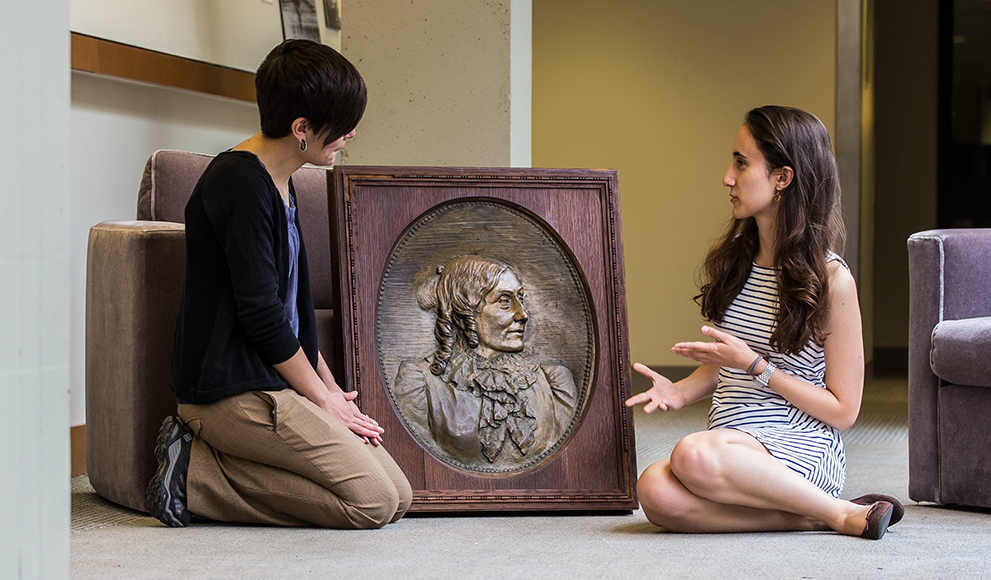A Missing Bronze Relief By the Renowned Sculptor Anne Whitney Was Located May 22 After a Months-Long Search

Mary Tileston Hemenway (1820–1894) was an important philanthropist, education reformer, and advocate of physical education. She founded numerous schools in the Boston area, including the Normal School of Gymnastics, which merged with Wellesley College to become the Department of Hygiene and Physical Education in 1909. That same year, a gymnasium was donated to the College in her name. A bronze relief depicting Hemenway, created by renowned poet and sculptor Anne Whitney, hung in the gym’s library until the complex was demolished in 1980’s to make way for the Keohane Sports Center.
“After the destruction of the old gymnasium, the relief was largely forgotten,” said Kathryn Cooperman ’15, who conducted an independent study on Whitney this spring with Jacki Musacchio, department chair and professor of art history, and Carlos Dorrien, studio director and professor of studio art, creating a virtual exhibition of Whitney's sculpture at Wellesley. She began her research in January by focusing on the eight known works at the College. But both Musacchio and Cooperman also wanted to try to find a ninth object, the Hemenway bronze relief.
“We had archival photographs of this relief, and references in Whitney's documents, but when the gymnasium was demolished to make way for Keohane Sports Center in 1984, it disappeared,” said Musacchio, who has studied Anne Whitney for several years.
Whitney, who taught at the College for one semester, was an important part of intellectual and artistic circles in the Boston area in the late nineteenth and early twentieth centuries. She was close to many of Wellesley's early faculty and staff, including Wellesley’s second president Alice Freeman and her husband George Herbert Palmer. Whitney’s statue of Harriet Martineau was a key feature of College Hall and campus ritual until it was destroyed in the 1914 fire.
Musacchio called the Hemenway relief an important object in terms of Wellesley's history, and Whitney's body of work. In an effort to locate it, she and Cooperman began assembling information from historical documents and photographs, and following leads that took them on a search involving both current and retired staff and locations across campus.
The Archives team couldn't find any record of the relief, nor could Davis Museum staff or Facilities. “Kathy Hagerstrom, the Assistant Director for Equipment and Operations at the KSC, walked us through that building, opening closets and boxes in the hopes that it had been tucked away and forgotten,” Musacchio said, “but we found nothing. Kathy encouraged us to contact Ann Batchelder, retired faculty in the Department of Physical Education; though she remembered it from her time at the College, she had no information on its current whereabouts.”
Then Musacchio had a chance encounter. “I was at a Friends of the Library meeting with Wilma Slaight, the College's first Archivist, and I asked her if she knew anything about it,” Musacchio said. Slaight did remember. “She immediately told me where it was stored in Archives after it was removed from the Gymnasium…it wasn't in that exact location but it was nearby, still wrapped up to protect it, more than 30 years after it was last seen.”
Current College Archivist Jane Callahan, and Director of Library Collections Ian Graham, located the relief on May 22; both Musacchio and Cooperman were thrilled.
“So much of Anne Whitney’s sculpture has been lost, destroyed, or out of the public eye for many years, and what little information exists as to the sculptures’ history can be extremely difficult to decipher,” said Cooperman. “Finding this relief was so important for my project, because it made scholarship about Whitney, which is so often ambiguous, more tangible, and it further elucidated one of the main goals of my project: illustrating the connection between Anne Whitney and Wellesley College.”
Wellesley's Archives, Special Collections, and Davis Museum have the largest collection of Whitney material in the world, including about four thousand of her letters and other archival material, and, now including the Hemenway relief, nine of her sculptures. In 2014, with funding from Friends of the Library and the McNeil Program for Studies in American Art, Musacchio and the Digital Scholarship Initiatives program launched Dear Home: The Letters of Anne Whitney, a crowd-sourced transcription site for the Wellesley community. Cooperman’s virtual exhibition will be incorporated into this site.
The bronze relief will remain in the Archives until an appropriate place can be found to install it in the future. Musacchio said she hopes people will be able to see it as a way to learn more about the work of Anne Whitney and Mary Hemenway and their connections to the College.
